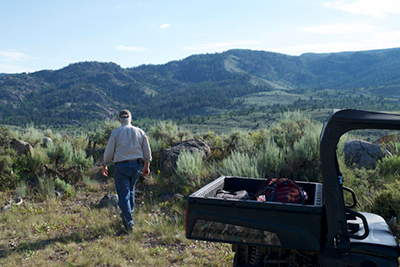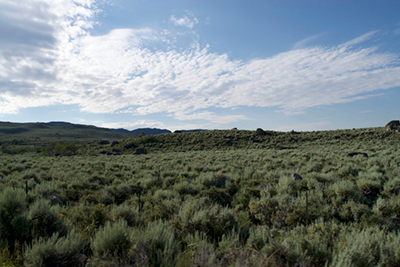
DeWitt Morris wanders through hip-high sagebrush on Mountain Springs Ranch on a sunny morning in western Wyoming. He stops at the edge of a bluff as two sage grouse hens flush near his feet, their big wings loud in the still air.
“Those were mature hens,” he said, then gestured at aspens shimmering along a small creek down below. “And their chicks are in there, I’m guessing.”
Wyoming’s spectacular Green River Valley, which lies at the base of the craggy 14,000-foot peaks in the Wind River range south of Jackson Hole, is home to all sorts of charismatic creatures. Herds of elk and deer roam the range, trout flash by in clear pools, and sage grouse gather by the hundreds on leks to perform their mating dance.
Some of the most critical migration and breeding corridors for these critters lie on private lands, particularly the rare and precious water resources that wildlife depend upon — like creeks, streams, springs, and wet meadows. Mountain Springs Ranch is no exception.
“This place is a highway for mule deer in the fall,” says John Lund, regional wildlife supervisor with Wyoming Fish and Game. “It’s also core habitat for the greater sage-grouse.”

But Mountain Springs Ranch, like much of the West, is under attack from a noxious weed called cheatgrass. This invasive annual grass outcompetes and replaces native plants in sagebrush country, eliminating nutritious forage for livestock and wildlife as well as disrupting processes that create healthy soil and water. Plus, cheatgrass is linked to hotter, more frequent wildfires that devastate western rangelands. Morris wanted to do something to stop this invasion on his ranch. As an avid hunter and fisherman, he was eager to improve wildlife habitat on the property.
“DeWitt really came to us with a desire to do something for sage grouse,” says Jennifer Hayward, district conservationist for the USDA Natural Resources Conservation Service out of Pinedale, Wyoming. “He worked with the Sage Grouse Initiative to address noxious invasive weeds, namely cheatgrass. ”
With support from SGI, Wyoming Game and Fish, and Sublette County Weed and Pest, Morris was able to spray the worst of the cheatgrass on his ranch, treating problem areas by road and aerially.
“Cheatgrass is a huge problem in the Western U.S.,” says Hayward. She points out the brown, brittle grasses, already bone-dry by June, much earlier than native perennial plants. “Native habitat is so very important, and cheatgrass is a threat to our way of life in Wyoming.”
Morris’ hope is that his ranch is a showpiece for how to proactively treat weeds. The goal is to encourage his neighbors to also control weeds, which would amplify the effects of his SGI contract to enhance surrounding rangelands.
“When we work together with landowners like DeWitt, it’s not just wildlife that benefits, it’s agriculture and cattle operations,” says Lund.
Morris has also partnered with the Jackson Hole Land Trust’s Green River Valley Program on a conservation easement that protects much of Mountain Springs Ranch for future generations. Across the West — and across America — we rely on private landowners like Morris to help conserve the lands and waters that support wildlife, agriculture, and our rural way of life. This is especially true in Wyoming, where private ranchlands provide some of the most valuable wildlife habitat in the state.
“If we can find the right solutions here, then we’ll provide better habitat for sage grouse, for mule deer, and for the domestic livestock that graze here, too,” says Morris.
 Sign In
Sign In
 Sign In
Sign In
